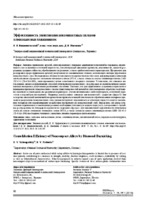| dc.contributor.author | Вишнепольский, Е. В. | |
| dc.contributor.author | Павленко, Д. В. | |
| dc.coverage.spatial | Минск | ru |
| dc.date.accessioned | 2019-02-11T11:37:06Z | |
| dc.date.available | 2019-02-11T11:37:06Z | |
| dc.date.issued | 2019 | |
| dc.identifier.citation | Вишнепольский, Е. В. Эффективность уплотнения некомпактных сплавов алмазным выглаживанием = Consolidation Efficiency of Noncompact Alloys by Diamond Burnishing / Е. В. Вишнепольский, Д. В. Павленко // Наука и техника. – 2019. – №1. – С. 62-69. | ru |
| dc.identifier.uri | https://rep.bntu.by/handle/data/49671 | |
| dc.description.abstract | Активное применение деталей, синтезированных с помощью аддитивных технологий из порошков, ограничивается из-за наличия остаточной пористости, способствующей снижению прочности, пластичности, вязкости разрушения, трещиностойкости, обрабатываемости резанием, а также триботехнических характеристик. Предложено для расширения сферы применения деталей, полученных из некомпактных сплавов, использовать методы упрочнения поверхностного слоя. Исследованы особенности локального поверхностно-пластического деформирования алмазным выглаживанием образцов из спеченного титанового сплава ВТ1-0, а также сплава на основе алюминидов титана LMD ОХ 45-3 (Ti–45Al–3Nb), синтезированного путем селективного лазерного спекания. Установлено, что алмазное выглаживание является эффективным способом уплотнения поверхностного слоя образцов из малопластичных некомпактных материалов, полученных различными способами. Показано, что для эффективного устранения пористости и повышения прочности поверхностного слоя несущих поверхностей деталей из этих материалов обработку необходимо выполнять в узком диапазоне режимных параметров с учетом механических свойств материала, остаточной пористости и параметров инструмента. Например, использование алмазных выглаживателей с радиусом сферы 0,5 мм вследствие маленькой контактной поверхности инструмента и низкой пластичности обрабатываемого материала приводит к разрушению поверхностного слоя, так как инструмент «проваливается» в большие поры, что ведет к скалыванию материала или неравномерному воздействию инструмента на поверхностный слой. Определено, что для результативного применения установленных режимов необходимо учитывать исходную пористость, которая имеет случайное распределение по площади поверхности исследуемых образцов. Для максимальной эффективности уплотнения сплава на основе спеченного титанового сплава ВТ1-0, а также сплава на основе алюминидов титана LMD ОХ 45-3 (Ti–45Al–3Nb) необходимо учитывать совокупное влияние параметров выглаживания. | ru |
| dc.language.iso | ru | ru |
| dc.publisher | БНТУ | ru |
| dc.title | Эффективность уплотнения некомпактных сплавов алмазным выглаживанием | ru |
| dc.title.alternative | Consolidation Efficiency of Noncompact Alloys by Diamond Burnishing | ru |
| dc.type | Article | ru |
| dc.identifier.doi | 10.21122/2227-1031-2019-18-1-62-69 | |
| local.description.annotation | Active use of parts synthesized while using additive technologies from powders is limited due to presence of residual porosity contributing to a decrease in strength, ductility, fracture toughness, crack resistance, workability by cutting, as well as tribotechnical characteristics. It has been proposed in order to expand scope of parts application derived from non-compact alloys to use methods of surface layer hardening. Specific features of local surface-plastic deformation have been investigated by diamond smoothing of samples from a sintered titanium alloy ВT1-0, as well as an alloy based on titanium aluminides LMD ОX 45-3 (Ti–45Al–3Nb) synthesized by selective laser sintering. It has been established that diamond burnishing is an effective method of compacting surface layer of samples from low-plastic non-compact materials obtained by various methods. It has been shown that in order to eliminate effectively porosity and increase strength of a surface layer for bearing surfaces of parts made from these materials, processing must be performed in a narrow range of mode parameters taking into account mechanical properties of the material, residual porosity and tool parameters. For example, application of diamond smoothers with a sphere radius of 0.5 mm leads due to a small contact surface of a tool and low ductility of the material being processed to destruction of the surface layer, as the tool “fails” into large pores, which causes spalling of the material or uneven effect of the tool on the surface layer. It has been determined that for the effective application of the established regimes it is necessary to take into account an initial porosity which has a random distribution over the surface area of the studied samples. For maximum compaction efficiency of an alloy based on a sintered titanium alloy ВT1-0, as well as an alloy based on titanium aluminides LMD ОХ 45-3 (Ti–45Al–3Nb), a cumulative effect of smoothing parameters should be taken into account. | ru |

